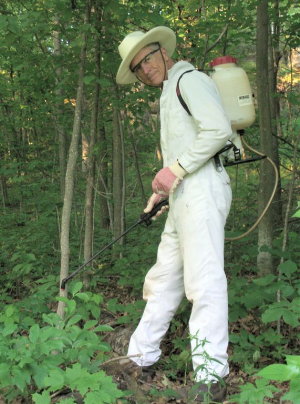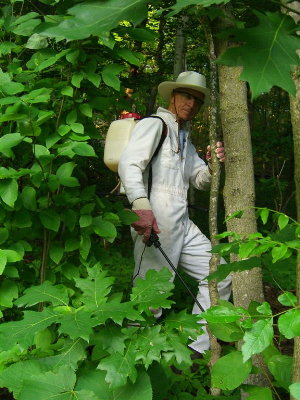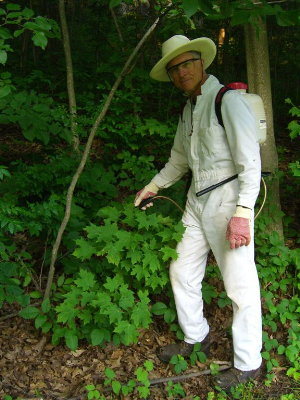Prescription for Ironwood
by Paul Richardson
Our hardwood woodlands were owned by dairy farmers for about one hundred years before we purchased them. During that time the quality trees were logged off, initially for use as building materials and later as a source of income. No timber stand improvement practices were used so that any deformed or damaged trees were allowed to grow. Also, no crop tree release was practiced so that there were too many trees crowded together preventing any from reaching their potential as quality timber trees. The worst thing that happened to the land was that cattle were grazed in the woods on a year round basis. The cattle ate the good tasting young preferred trees (e.g. oak, maple, ash) and did not bother ironwood and blue beech. The result was a forest where the dominant trees were ironwood and blue beech.
Until seven years ago we thought our woods were beautiful, that is, lots of trees with green leaves. We became interested in forest management and joined the Kickapoo Woods Cooperative after attending one of their field days. That was the beginning of our education in forest management which will continue as long as we live. We've now attended dozens of forest management field days, workshops, and conferences. We joined The Wisconsin Woodland Owners Association and the American Tree Farm System, and subscribe to several woodland management magazines. Our library contains several books on silviculture which we refer to regularly.
Some of our woods are now enrolled in the Managed Forest Law program of the Wisconsin Department of Natural Resources. One of the recommendations the DNR made in our plan made was to "reduce the number of ironwood and blue beech trees." Our options on how to do that are: use a chain saw to cut the tree down at ground level and then apply Garlon to the stump to prevent re-growth; cut the tree down three feet above ground level and hope the tree doesn't re sprout (it usually won't but then the woods are littered with three foot tall obstacles); and finally, the method we chose, use a back-pack sprayer to apply Garlon 4 and Diesel fuel mix to the bottom eighteen inches of the tree trunk.
Our woods contain literally tens of thousands of Ironwood and blue beech trees. The time and effort required to use a chain saw to cut them down is too much. We do our ironwood control in the summer when the leaves are on the trees. Chain sawing in the summer is hot, sweaty, noisy, work. We've tried it and the best we could average is sixty trees an hour and then the woods are littered with the downed trees which we must now navigate around.
My adult son and I each use a Solo brand back-pack sprayer filled with an eight per-cent solution of Garlon 4 mixed with Diesel fuel. We wear white summer weight coveralls and a white wide brimmed straw hat. We slip a small metal counter on one of our fingers so that for each tree we treat we click the counter to keep track of how many trees we get per tank. Even though the term for what we do is called basal bark spraying, we do not spray - we drizzle. We place the nozzle of the sprayer against the trunk of the tree and, with the nozzle set for a solid stream rather than a spray pattern, we pump the handle just enough to cause a dribble of Garlon mix to run down the trunk. While slowly stroking the pump we circle the nozzle around the trunk until the bottom eighteen inches of the tree is soaked. But, we do not let any of the Garlon mix get to the ground. Nor do we let any of the mix get on our shoes or clothing. It takes us about an hour and a half to use up the three gallons of mix in each of our tanks. If the trees are about one inch in diameter we can treat more than four hundred trees per tank. When treating much larger trees I've treated as few as one hundred trees per tank. We spray in the morning when it is cool and each of us only does one tank per day. Our land is hilly and an hour and a half hiking the hills with a back pack sprayer on is enough. That lets us do other things with our day and we don't get burned out treating ironwood. Thus far we have treated more that fifteen thousand trees and there are more than a hundred acres yet to be treated!
The Garlon 4 label on the container will tell you to use a 20% mix, but we have experimented with various concentrations and found that 8% works best for our method of treatment. We carefully measure out 32 ounces of Garlon 4 into our empty back-pack sprayer. Next we mark a permanent black line on the side of the sprayer at the 32 ounce level so that refilling with the same mix is faster than measuring each time. Then we add 352 ounces of Diesel fuel and mark that level on the side of the sprayer. You can substitute mineral oil or Canola oil for the Diesel fuel. The great thing about Garlon 4 is that it is designed to break down into harmless compounds in forty-five days. The O-ring seal of the Solo sprayer needs to be lubricated with Vaseline to keep it from leaking. Be tidy and particular in your procedures so that you don't get any of the mix on you. If you do, shower right away and put on clean clothes.
Within in few weeks of treatment the tree will lose its leaves and the sunlight will get to the forest floor, but the dead tree will stand for a couple of years. When it does fall it will be dry and light and it will not leave a stump but rather pull its small root flare with it. It is amazing how much more sunlight gets to the forest floor when all the ironwood and blue beech lose their leaves. We now have lots of oak, maple, ash and hickory seedlings popping up where there was once only ironwood shade.
Richwood Timber LLC
richwoodtimberllc (at) w9fz.com


